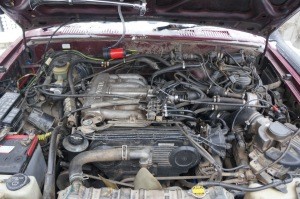
Engine 3VZ-E
 The family of gasoline ICEs of the VZ series, manufactured by Toyota, to which the 3VZ-E engine belongs, first saw the light in the fall of 1987. The impetus was the development of the nearest competitor - Nissan Corporation, which in 1983 demonstrated Japan's first V-shaped six-cylinder internal combustion engine at the Tokyo Motor Show. A typical member of the Nissan engine family, the VG was a powertrain consisting of a metal block and an aluminum cylinder head. The twelve-valve gas distribution mechanism was made according to the SOHC scheme, the total volume of cylinders in the series ranged from 2.0 to 3.3 liters.
The family of gasoline ICEs of the VZ series, manufactured by Toyota, to which the 3VZ-E engine belongs, first saw the light in the fall of 1987. The impetus was the development of the nearest competitor - Nissan Corporation, which in 1983 demonstrated Japan's first V-shaped six-cylinder internal combustion engine at the Tokyo Motor Show. A typical member of the Nissan engine family, the VG was a powertrain consisting of a metal block and an aluminum cylinder head. The twelve-valve gas distribution mechanism was made according to the SOHC scheme, the total volume of cylinders in the series ranged from 2.0 to 3.3 liters.
The response was not long in coming. Throwing all its efforts into development, just four years later, Toyota showed the world an improved version of its competitor's flagship - the 3VZ-E gasoline internal combustion engine. The cylinder block for the VZ series was produced exclusively by casting. At the same time, the supporting elements of the gas distribution mechanism drive were immediately formed. The development of the cylinder head was entrusted to Yamaha, which brilliantly coped with the task. Good performance indicators of power and torque made it possible to use engines for both trucks and cars.
Design features, advantages and disadvantages
This power unit is a two-row V-shaped six-cylinder engine with separate, one for each row, cylinder heads. The gas distribution mechanism, designed according to the SOHC scheme, controls twelve intake and exhaust valves. GMR drive - belt, from the crankshaft located in the cylinder block.

Due to the large camber angle, the Toyota 3VZ-E engine turned out to be low, but wide, which gives an additional advantage when placed in the engine compartment of a car with a low seating position. In addition, such a mutual arrangement of the cylinders makes it possible to achieve more uniform intervals for igniting the fuel-air mixture.
The main disadvantage of 3VZ-E is its tendency to overheat. In case of improper operation, or violation of the order of adding coolant, the cylinder heads can lead, which leads to rupture of the gasket and loss of tightness. A careless repair of the 3VZ-E only exacerbates the situation.
The engine's propensity for excessive absorption of gasoline and oil is due more to the life of the engine (it was discontinued in 1997) than to design miscalculations. The 3VZ-E throttle valve becomes clogged with combustion products over a long period of engine operation, which leads to uneven running of the car. The problem is easily fixed by cleaning the contaminated part.
Specifications 3VZ-E:
| Engine capacity | 2958 cm/cu |
| Power/revs | 150 hp / 4800 rpm |
| Bore | 87.5 mm |
| Piston stroke | 82 mm |
| Gas distribution mechanism | SOHC |
| Recommended fuel | gasoline A-92 |
| Engine resource 3VZ-E | 450000 km |
Where was 3VZ-E used
In 1988, the first cars came off the assembly line using the 3VZ-E as a power unit. Among them were:
- Toyota 4Runner equipped with this engine until 1995
- Toyota Pickup, before 1995
- Jeep Toyota T100 between 1992 and 1995
At the moment, all cars and engines imported into the country have been overhauled, and often, the speedometer has been corrected. In such a situation, it is difficult to make a judgment about whether the engine is good or bad.

